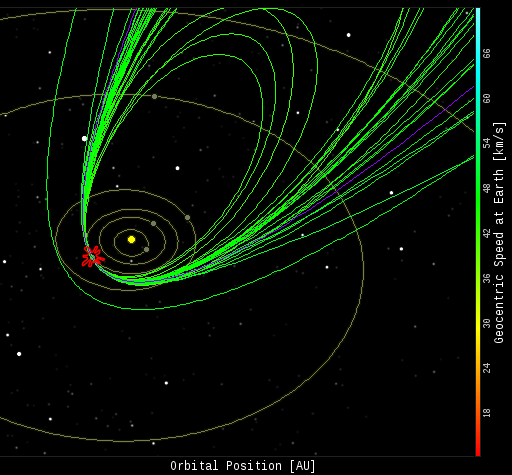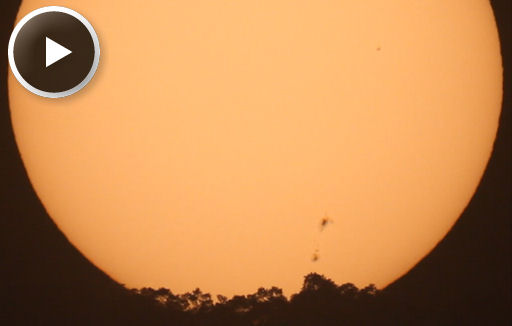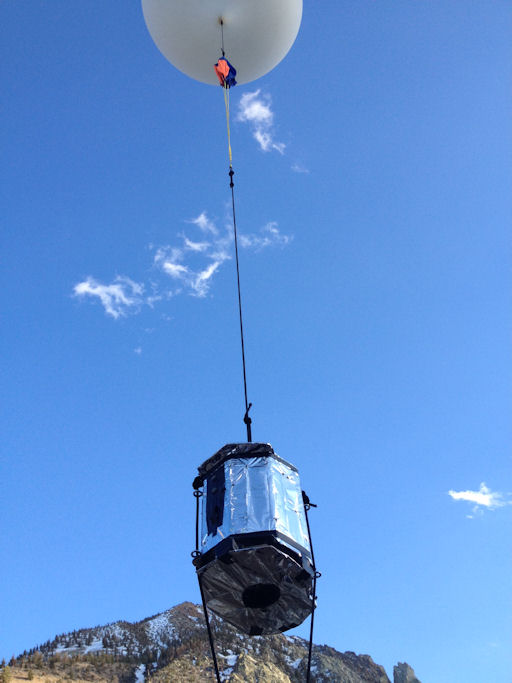They came from outer space--and you can have one! Genuine meteorites are now on sale in the Space Weather Store. | | |
THREE YEARS IN THREE MINUTES: Launched in 2010, the Solar Dynamics Observatory has been in space, watching the sun without interruption for three years. To celebrate the accomplishment, NASA has prepared a time-lapse video compressing 36 months of solar activity into just a few minutes: Watch it!
LYRID FIREBALLS: For the past few days, Earth has been passing through a stream of debris from ancient Comet Thatcher, source of the annual Lyrid meteor shower. According to international observers, the encounter produced as many as 25 meteors per hour. Some of these were fireballs. NASA's All Sky Fireball Network detected more than 30 Lyrids as bright as Venus on the nights around the shower's April 22nd peak. Here are their orbits:

In the diagram, the red splat marks the location of Earth; green elipses are the orbits of the meteoroids, triangulated by multiple cameras in the meteor network.
"The purple ellipse is the orbit of Comet Thatcher," adds Bill Cooke, lead scientist for NASA's Meteoroid Environment Office. "The orbits of the comet and the meteoroids match up nicely." According to Cooke, the Lyrid fireballs penetrated Earth's atmosphere as deeply as 44 miles above the planet's surface, traveling at an average speed of 105,000 mph.
The shower is subsiding now as Earth exits the debris stream.
Realtime Meteor Photo Gallery
BIG SUNSPOT: Fast-growing sunspot AR1726 is now so large that people are noticing it as blemish on the solar disk, visible when the sun is dimmed at sunrise or sunset. Bartholomew Tsang sends this evening snapshot from the Ho Koon Nature Education cum Astronomical Centre in Hong Kong:

The behemoth active region, which spans more than 150,000 km from end to end, has a delta-class magnetic field that harbors energy for strong eruptions. NOAA forecasters estimate 40% chance of M-class solar flares and a 15% chance of X-flares during the next 24 hours. Solar flare alerts: text, voice.
Realtime Space Weather Photo Gallery
SPACE WEATHER BALLOON: On April 20th in the Sierra Nevada mountains near Bishop, California, a group of high school students launched a "space weather balloon" into the stratosphere. Their goal is to monitor the effects of solar flares on Earth's atmosphere. Scroll below the image for more information:

The silver capsule, built by Mihai Ciustea of Sammamish WA and launched by the Earth to Sky team of Bishop CA, is bristling with sensors to measure, e.g., ozone, pressure, humidity, acceleration and other variables of interest. The capsule travels to 125,000 feet--well inside Earth's ozone layer--and lingers there for approximately two hours before parachuting back to Earth with the data. The April 20th launch was a test flight to measure baseline levels when solar activity is relatively low.
The capsule also serves another purpose: It is a bacteria collector. A door at the bottom of the capsule can open, guiding air into a filter designed to capture microbes during the flight. Mihai Ciustea hopes to find ice-nucleating bacteria and other lifeforms living high above Earth's surface. Stay tuned for updates about this mission!
Realtime Aurora Photo Gallery
Realtime Comet Photo Gallery
Realtime Noctilucent Cloud Photo Gallery
[previous years: 2003, 2004, 2005, 2006, 2007, 2008, 2009, 2011]

